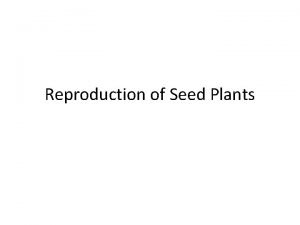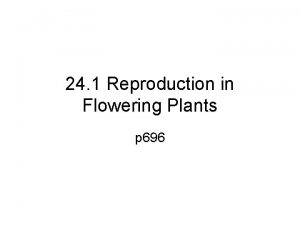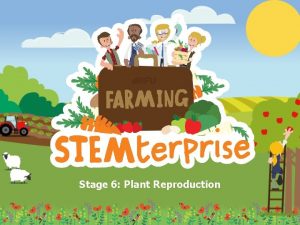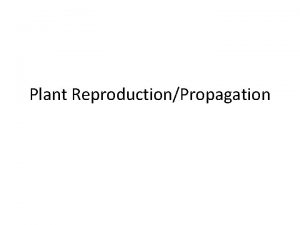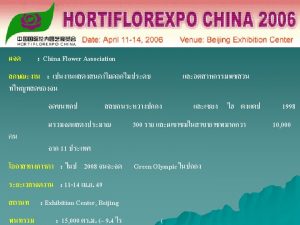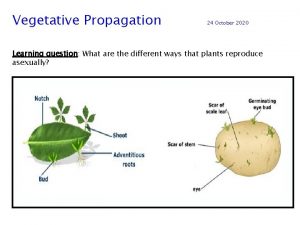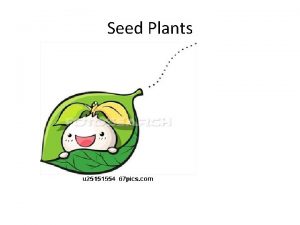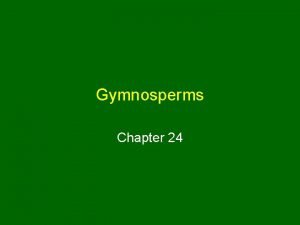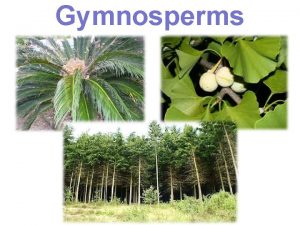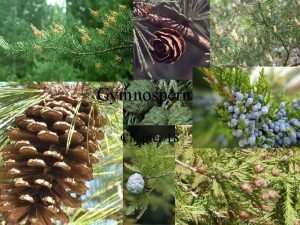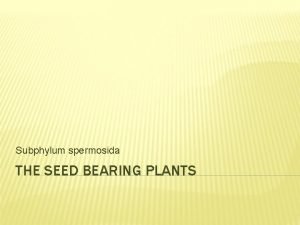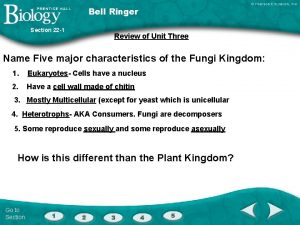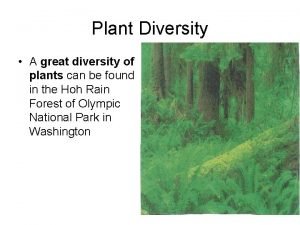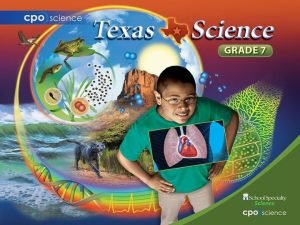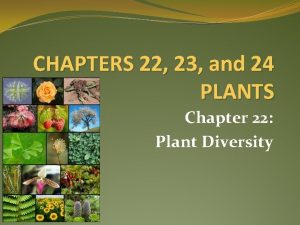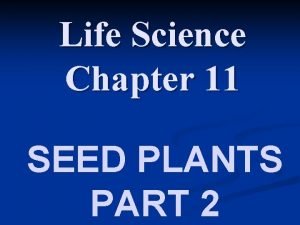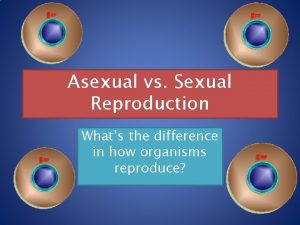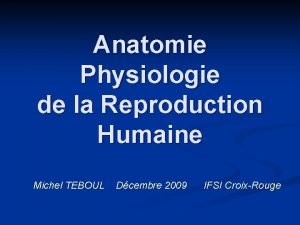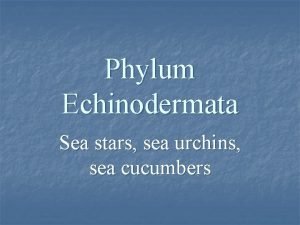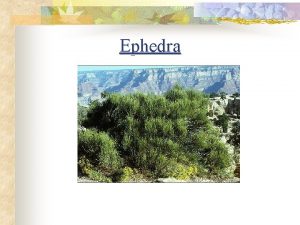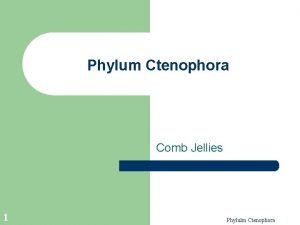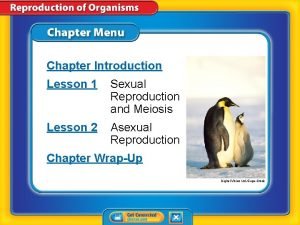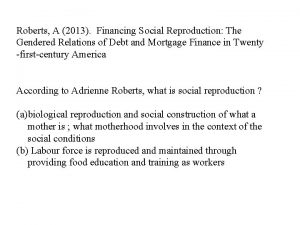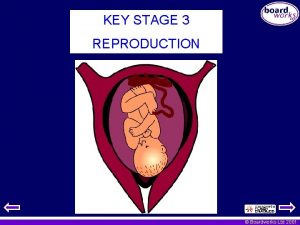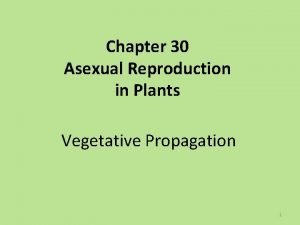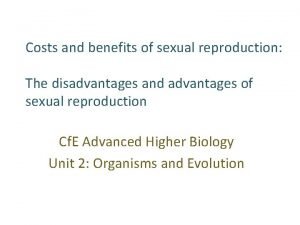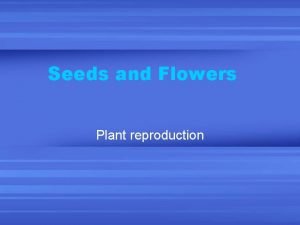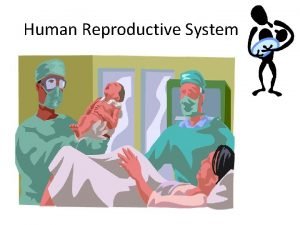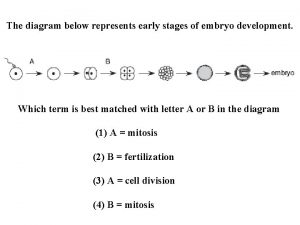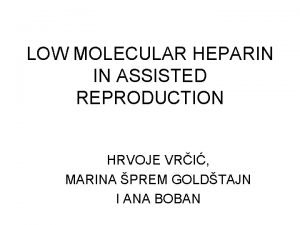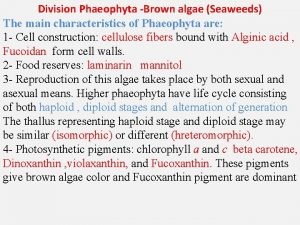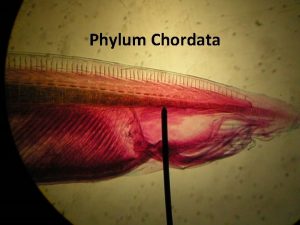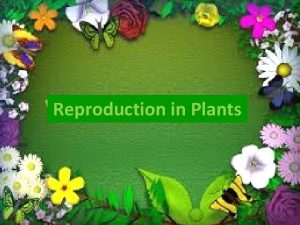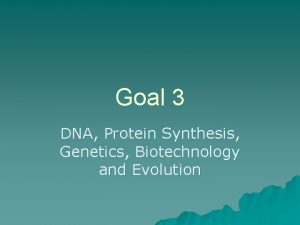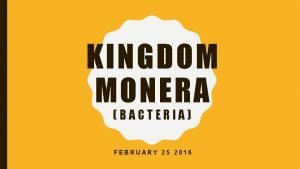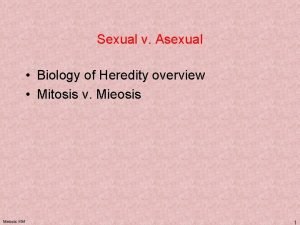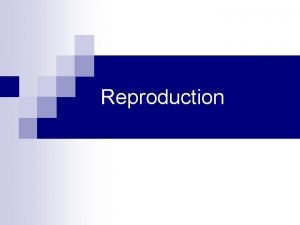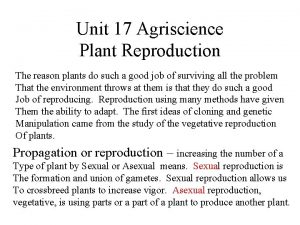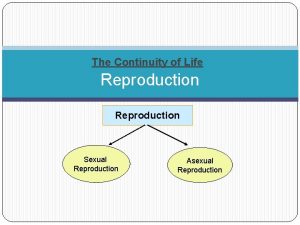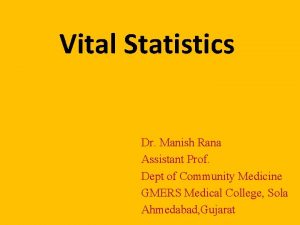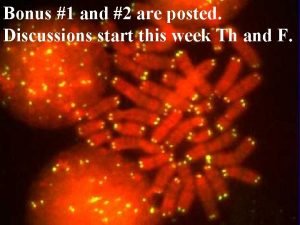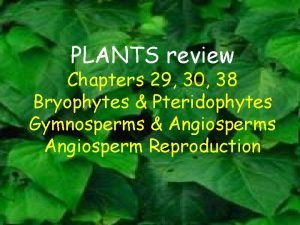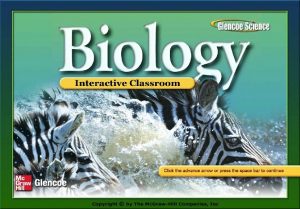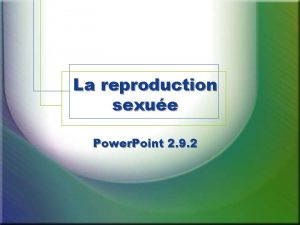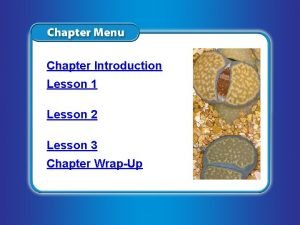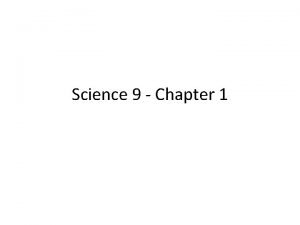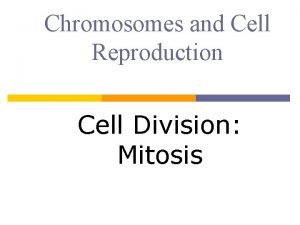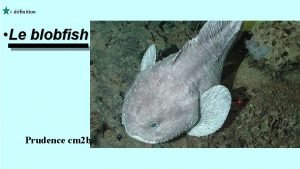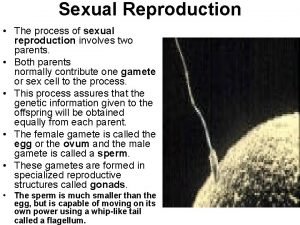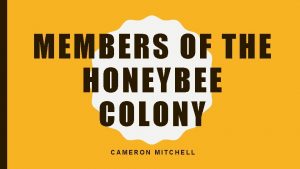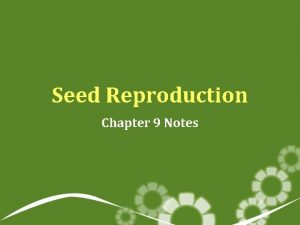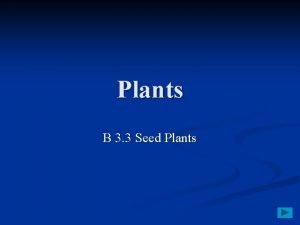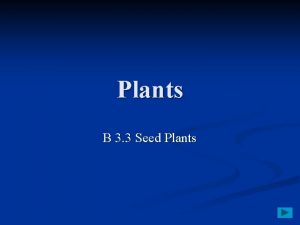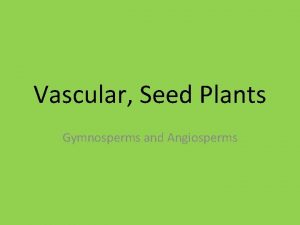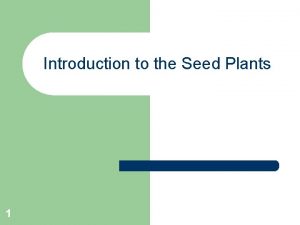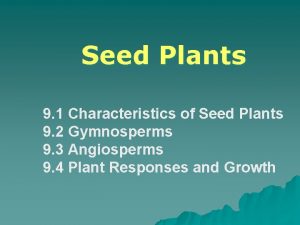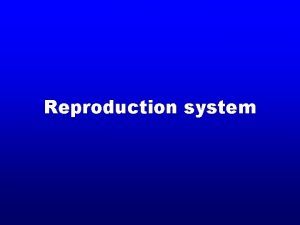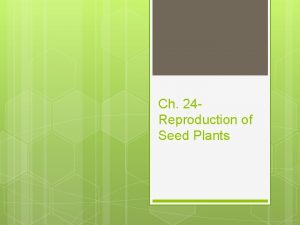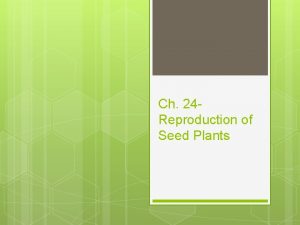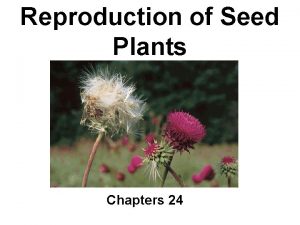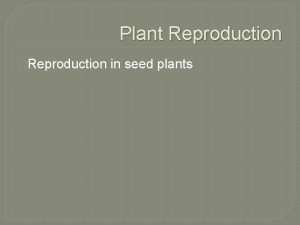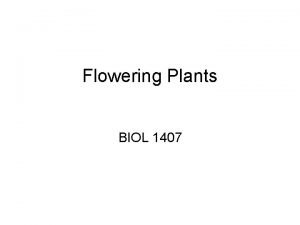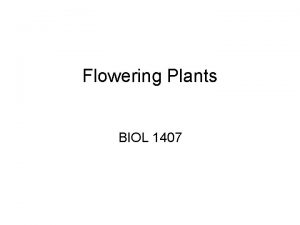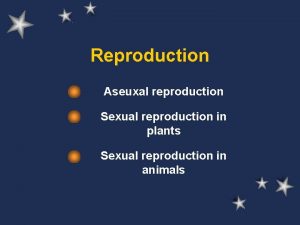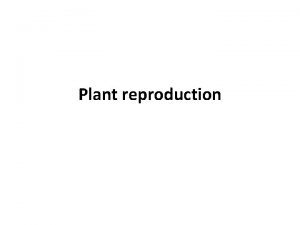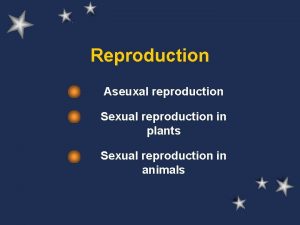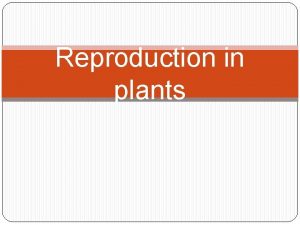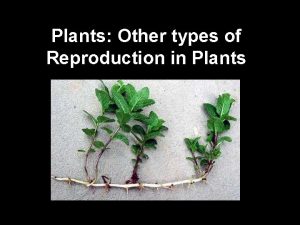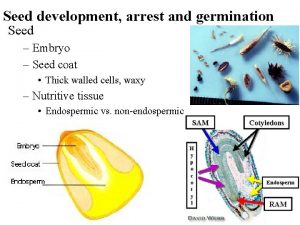Reproduction of Seed Plants Reproduction of Seed Plants







































































- Slides: 71

Reproduction of Seed Plants

Reproduction of Seed Plants • Remember that seed plants are very well adapted to life on land – they don’t need water for fertilization as ferns and mosses and other seedless plants do. Having seeds and either cones or flowers allows gymnosperms and angiosperms to reproduce almost anywhere.

Alternation of Generation • In seed plants, the dominant and recognizable form of the plant is the diploid sporophyte. The gametophyte in a seed plant is found inside the cones of gymnosperms and inside the flowers of angiosperms.

Life Cycle of Gymnosperms • Reproduction in Gymnosperms takes place in cones produced by the mature sporophyte.

Pollen Cones • Male gametes are produced in pollen cones (also called male cones). These pollen cones produce the male gametophytes, which are called pollen grains – this is the entire male gametophyte generation.

Seed Cones • Female gametophytes are produced in seed cones; which are the larger cones we are familiar with. 2 ovules are produces at the bottom of each scale of the cone, and the female gametophytes develop inside these ovules. When mature, each female gametophyte contains a few large egg cells, each of which can be fertilized by a sperm nucleus from the pollen.

Pollination • In spring, male pollen cones produce huge numbers of pollen grains. • Pollen is carried by the wind, and some will reach female cones, where they get stuck to a sticky secretion (called pollination drop) on the scales. Pollination drop helps to ensure that the pollen stays on the female cone so fertilization can occur.

Fertilization • Pollen grain lands near an ovule, the pollen grain splits open and produces a pollen tube – Pollen tube contains 2 haploid sperm nuclei – When it reaches the female gametophyte, 1 sperm nuclei fertilizes it, and the other sperm nuclei disintegrates • If a sperm from a different pollen tube reaches the female gametophyte, more than 1 egg can be fertilized, but only 1 will develop into an embryo.

Fertilization • At fertilization, a diploid zygote is formed – this is the first cell of a new sporophyte plant – Zygote divides by mitosis to develop into an embryo

Development • The seed starts to form; it has made up of tissues from a combination of 3 generations – The outer seed coat is from the old sporophyte generation – The embryo is the new sporophyte generation – Between these is a layer of haploid cells from the female gametophyte

Structure of a Flower • We think of flowers as decoration, but really, they are the reproductive organs of angiosperms.

Sepals and Petals • Sepals are the small, usually green, leaf-like structures that cover the bud before it opens and protect the flower when it is developing. • Petals are found just inside the sepals, and they are modified leaves which are usually brightly coloured to attract pollinators.

Stamens and Carpels • Moving inward from the petals, we come to the structures that produce the gametophytes. • The male structure is the stamen, which is made up of two parts: – Filament – a long thin stalk that supports the anther – Anther – an oval sac at the top of the filament, this is where meiosis occurs to produce the haploid male gametophytes (pollen grains). • If you touch a flower, you may get yellow-gold dust on your fingers – this is pollen, made up of thousands of individual pollen grains. – Most flowers contain several stamens

Reproduction Song – Grease 2 • https: //www. youtube. com/watch? v=x 3 OQaa m. Ls. So

Stamens and Carpels • The female part is found in the middle of the flower, and is called the carpel (or the pistil). Parts of the carpel: – Ovary – the broad base of the carpel, it contains the ovules, where the female gametophytes are produced. – Style – the narrow stalk that forms the upper portion of the carpel – Stigma – the sticky portion at the top of the style, where pollen grains land • Some flowers have multiple carpels fused together into a compound carpel.

Stamens and Carpels • Most plants have flowers that produce both the male and female gametophytes. • However, in some plants the two types of gametophytes are produced in separate flowers on the same individual • In some plants many flowers grow together into a composite flower – Example: sunflowers

Composite Flower

Life Cycle of Angiosperms • Reproduction in angiosperms occurs within the flower. After pollination and fertilization, the seeds develop inside protective structures. • The mature sporophyte produces flowers. In most cases, each flower contains both anthers and an ovary

Producing Pollen • In the anthers, the haploid spores are produced meiosis, which each develop into a male gametophyte (pollen grain) – The pollen grain develops a hard wall to protect it from drying out – The nucleus of the pollen grain goes through mitosis once to produce two haploid sperm nuclei – The pollen grain stops growing until it is deposited on a stigma

Producing The Egg • The female gametophyte is produced in the ovules, which are contained in the ovary. – A diploid cell undergoes meiosis to produce 4 haploid cells. Only 1 survives, and it then goes through mitosis to produce eight nuclei in a single membrane, called the embryo sac. • This embryo sac is the female gametophyte. • One of the nuclei becomes the egg nucleus – the female gamete

Zygotes • If fertilized, this egg will form part of the zygote that will grow into the new sporophyte plant – The embryo cells begin to differentiate, developing into specialized cells as part of the new sporophyte or seedling.

Pollination • Now that the male and female gametophytes have been produced, it is time for pollination to occur. • Where most gymnosperms are pollinated by the wind, most angiosperms are pollinated by animals, and only a few angiosperms use wind pollination.

Animal Pollination • Pollinators are animals that carry pollen from one flower to another; most pollinators are insects, birds, and bats

Animal Pollination • Animal pollination is much more efficient than wind pollination (A great example of mutualism) – Wind pollinated plants must produce large quantities of pollen, and depend on weather conditions for pollination to occur lots of wasted pollen – Animal pollinated plants have many adaptations to improve the effectiveness of pollination • Brightly coloured petals to advertise to pollinators • Sweet nectar to reward pollinators

Attracting Pollinators • Some have specific shapes or behaviours depending on their main pollinator species – A “landing pad” for insects – Long corollas for hummingbirds – Blooming at night for bats Insect pollination may be the factor that is mostly responsible for angiosperms outcompeting gymnosperms over the last 100 million years!

Benefit for Pollinators • What’s in it for the pollinator? – Provides a dependable source of food for the pollinator Nectar, pollen, or both

Fertilization in Angiosperms • A pollen grain lands of the stigma of a flower of the same species, and begins to grow a pollen tube. • The pollen tube grows down into the style, and all the way to the ovary and into the ovule.

Two Fertilizations • The pollen tube contains two sperm nuclei, and then two distinct fertilizations take place – 1 sperm nucleus fuses with the egg nucleus to produce the diploid zygote – The other sperm nucleus fuses with two polar nuclei (extra cells that are produced by meiosis when the egg nucleus is formed), to form a triploid (3 N) cell • This triploid cell will grow into the endosperm, a foodrich storage tissue which provides nourishment to the embryo and seedling as it grows

Double Fertilization • This process is known as double fertilization • Thought to be one of the reasons that angiosperms have been so successful – In gymnosperms the food reserve is built up before fertilization if fertilization doesn’t occur, the food in that ovule is wasted! – Angiosperms are more efficient, since food isn’t stored for the seed until fertilization has occurred no wasted food.

Crash Course: Plant Reproduction • https: //www. khanacademy. org/partnercontent/crash-course 1/crash-coursebiology/v/crash-course-biology-137 (9: 46)

Seed & Fruit Development • Once fertilization has occurred, the parent plant sends nutrients to the flower to support development of the seed. • In Angiosperms, the ovary walls thicken and form a fruit around the developing seeds. • Parts of the ovule become tougher and form the seed coat (outer protective layer of the seed, enclosing the embryo and the food supply). • The ovary wall thickens and may join with parts of the stem, to form the fleshy part of the fruit.

Fruits • Biologically speaking a fruit is any seed that is enclosed within the ovary wall. – Examples: apples, grapes, peas, corn, beans, rice, tomatoes

Types of Fruits • There is a wide variety of types of fruits – Fleshy tissues: grapes, tomatoes – Tough tissues: bean pods – Inner wall of ovary attached to the surface of the seed: peaches, cherries – Dry fruit in an aerodynamic shape: maples

Seed Dispersal Video • https: //www. youtube. com/watch? v=x. Y 4 JFOS uqv. Y (12 min) • 10 Things - for your logbook – Write down at least 10 things that you found interesting or important, from the video • If time: Exploding Seeds! https: //www. youtube. com/watch? v=n. Hq. HSp. Z hje. Y (2: 30)

Dispersal by Animals • Seeds with (usually) sweet, fleshy fruits are intended to be eaten by animals – These seeds usually have a tough coating to protect the seed from the harsh digestive chemicals in the digestive tract of the animals – Then the seeds are deposited in another distant location, in a patch of the animal’s feces, which provide a natural fertilizer

Dispersal by Animals • The sweet, nutritious fruits provide an important source of food for animals, and the animals help disperse the seeds longer distances than the plants could manage on their own Another example of mutualism

Dispersal by Wind and Water • Lightweight seeds are specialized to be dispersed by wind or water – Wind: • Ash and maple seeds have wings • Tumbleweeds break off at their roots and tumble along the ground, scattering their seeds as they go.

Dispersal by Water • Coconuts are a large seed filled with the liquid endosperm (the coconut milk), which helps it to be buoyant enough to float in seawater for up to weeks – This has allowed coconuts to spread to remote islands effectively

Seed Dormancy • Some seeds germinate almost immediately when they land in a suitable location • However many seeds enter a period of dormancy (where the embryo is alive but not growing), from a few days to weeks, years or even decades. – The oldest known seed that was still able to germinate was over 2000 years old!

Seed Dormancy • Seed Dormancy video – https: //www. youtube. com/watch? v=JRc 7 FAHi. NO o (1: 23)

Benefits of Dormancy • Long-term dormancy can allow for longdistance dispersal (such as coconuts floating to a new island) • Can allow seeds to germinate under ideal conditions (such as spring instead of summer or winter, or when competition is reduced)

Ending Dormancy • Environmental factors such as air temperature and moisture can trigger a seed to end dormancy and germinate • Some plants (such as bishop pines and lodgepole pines) have a resin coating on their seed cones, and require the high temperatures of a severe forest fire to open – this ensures that the seeds will have very little competition when they germinate.

Seed Germination • Germination is the early growth of a plant embryo • Seeds absorb water – This water causes the endosperm tissues to swell, cracking the seed coat open • Young root emerges through this crack and starts to grow

Shoot Development • Development of the shoot varies – In most monocots, the single cotyledon (seed leaf) stays underground, and the new shoot emerges, protected by a sheath – In dicots, there are 2 main possibilities • The two cotyledons can emerge above ground and protect the stem and the first foliage leaves – The cotyledons will then either wither and drop off, or become photosynthetic (pumpkin) • The cotyledons can stay underground, and provide a food source for the new seedling

Germination

Mung Bean Germination (if time) • https: //www. youtube. com/watch? v=p. B 4 ASd. E LBb. Q (3 min)

What is Asexual Reproduction? • Asexual reproduction is any type of reproduction that involves only one parent. • All offspring from asexual reproduction are genetically identical to the parent and to each other. These identical offspring are sometimes called clones.

Advantages • One advantage of asexual reproduction is that many offspring can be produced very quickly, creating a large population. • When the environment is stable, genetic variability is not very important, so this can be a very successful strategy.

Disadvantages • The main disadvantage is that any factor that negatively affects the parent will also impact all of the offspring in the same way. • This means that a single environmental change or a new drug or disease can wipe out the whole population very easily.


Vegetative Reproduction • The asexual production of genetically identical offspring (clones) from the parent plant, without the formation of a seed. Since it does not require pollination or seed formation, it allows plants to reproduce very quickly. • Different plants have can use different methods of vegetative reproduction, including stolons, plantlets, and rhizomes.

Stolons • Stolons are long, trailing horizontal stems (commonly called runners), which produce roots when they touch the ground. Once these new roots are established, a new plant starts to grow, and the stolon can be broken, creating a completely independent new plant. – Strawberry plants are a great example of this.


Plantlets • Plantlets are tiny new plants that form at the ends of elongated stems, without needing to touch the ground. If these plantlets break off and fall to the ground, or something happens to the parent plant, they can grow roots and form a whole new plant. – Spider plants are very well known for producing multiple plantlets

Spider Plants

Rhizomes • Rhizomes are underground stems that can send up multiple new shoots from beneath the soil. – Bamboo forests are a good example of this – the whole forest can be a group of clones of the same original bamboo plant.

Bamboo Rhizomes Bamboo growth time lapse video: https: //www. youtube. com/watch? v=-a. ARFhj. J 7 EA (2 min)

Plant Propagation for Human Use • When a plant has traits that are particularly desirable, often gardeners and horticulturalists will want to make more plants with the same traits. • However simply breeding the plant normally (sexual reproduction through pollination) produces additional genetic variation; which may interfere with the desired trait.

Plant Propagation for Human Use • Additionally, some food crops have been specifically bred to produce seedless varieties. These plants cannot reproduce sexually through pollination and seed production, so gardeners must intervene. • In both of these cases, propagation techniques are used to produce new plants through asexual reproduction.

Cuttings • The simplest way to propagate a plant is using cuttings. • The gardener cuts a length of stem including several buds (with their meristematic tissue), and then “plants” the cutting into soil. • Some plants produce new roots easily in this setting, while others (particularly woody plants) often require the addition of plant hormones called rooting powders.


Grafting • Generally used to reproduce seedless varieties of plants, and woody plants that have a harder time producing roots. • A piece of stem (or a lateral bud) is cut from the parent plant and attached to another plant. The vascular cambiums of the two plants must be firmly connected to each other, or it will not work.

Grafting • This procedure is generally most effective if performed when plants are dormant – wounds can heal before growth begins. • The cut piece is called the scion and the plant it is attached to is called the stock. When the scion is a stem, this procedure is known as grafting. When the scion is a bud, it is known as budding. • This technique can be used to grow more than one flower or fruit on the same tree or bush – Fruit salad trees – Can help preserve endangered species

Fruit Salad Tree company: https: //www. fruitsaladtrees. com/Home Tree of 40 Fruit: http: //time. com/3086552/tree-of-40 -fruit-sam-van-aken/

Plant Tissue Cultures • Plant cells can be placed in a petri dish with nutrients and grow into new individuals. • Once they have developed into a seedling, they can be transplanted into soil and then continue to grow normally. • This can be used to preserve endangered species of plants, or to clone plants for use in experiments.

Agriculture • When humans started cultivating plants for their own use, it caused major changes to human society. • Later, as explorers visited other parts of the world, food crops were shared and transported back home. • In fact, many of the foods we associate with a particular country, were actually introduced from somewhere else relatively recently.


Imported Plants • Great plains are the “breadbasket” of North America – wheat originated in the Middle East • Tomato sauce is a key part of Italian food – tomatoes originated in North America • Potatoes are key to German and Irish food – potatoes are also from North America • Rice is now included in Mexican foods such a burritos – rice originated in China, spread to Europe, and then was introduced to Mexico by the Spanish

Crops • Today thousands of plants (mostly angiosperms) are used as food crops around the world. However relatively few crops, are used to provide most of the food supply (for humans and livestock) around the world. For example, in the US over 80% of the cropland is used for growing wheat, corn, soybeans and hay.

Crops from Grass • Interestingly 3 of these (wheat, corn, and hay) are modified types of grasses. This is an example of how selective breeding (even by accident) can have major effects on plants and on humans.

Homework • Remember to finish reading all sections from this chapter, and do the assigned questions • Logbook Due tomorrow – Don’t forget the glossary, the 10 things from yesterday’s video (posted on my website) • Notebook Quiz tomorrow – Chapter 22
 Seed plants reproduction
Seed plants reproduction Sexual reproduction and asexual reproduction
Sexual reproduction and asexual reproduction Sexual and asexual reproduction in animals venn diagram
Sexual and asexual reproduction in animals venn diagram Asexual reproduction cell division
Asexual reproduction cell division Male reproductive system of a plant
Male reproductive system of a plant Female parts of a flower
Female parts of a flower Plants and animals reproduction venn diagram
Plants and animals reproduction venn diagram Learning objectives of reproduction in plants
Learning objectives of reproduction in plants Significance of mitosis and meiosis ppt
Significance of mitosis and meiosis ppt A sexual reproduction in plants
A sexual reproduction in plants Examples of vegetative propagation
Examples of vegetative propagation Nonvascular plants reproduction
Nonvascular plants reproduction Seed plants are divided into
Seed plants are divided into Bean seed labeled parts
Bean seed labeled parts Seeds are present but naked in
Seeds are present but naked in Genesis all seed bearing plants
Genesis all seed bearing plants Seed producing vascular plants
Seed producing vascular plants What are the two major groups of seed plants
What are the two major groups of seed plants Life cycle of seed bearing plants
Life cycle of seed bearing plants Section 22-4 seed plants answer key
Section 22-4 seed plants answer key Structure of a fern
Structure of a fern Lesson 11 seed plants
Lesson 11 seed plants Section 22-4 seed plants
Section 22-4 seed plants Lesson 11: seed plants
Lesson 11: seed plants Vascular plants
Vascular plants Flowering and non flowering plants similarities
Flowering and non flowering plants similarities C3 plant
C3 plant Asexual reproduction cell division
Asexual reproduction cell division Reproduction
Reproduction Whats asexual reproduction
Whats asexual reproduction Blastocèle
Blastocèle Do sea urchins reproduce sexually or asexually
Do sea urchins reproduce sexually or asexually Reproduction of ephedra
Reproduction of ephedra Phylum ctenophora characteristics
Phylum ctenophora characteristics Reproduction of organisms
Reproduction of organisms Social reproduction definition
Social reproduction definition What is reproduction
What is reproduction Bulbs
Bulbs The ninny by anton chekhov theme
The ninny by anton chekhov theme Parthenogenesis asexual reproduction
Parthenogenesis asexual reproduction Pterophyta reproduction
Pterophyta reproduction Human reproductive system
Human reproductive system 31 days
31 days Reproduction in human
Reproduction in human Brown algae phylum
Brown algae phylum Chordata
Chordata Basil nkenchor
Basil nkenchor Spore formation reproduction
Spore formation reproduction Asexual reproduction of budding
Asexual reproduction of budding Monera kingdom reproduction
Monera kingdom reproduction Chapter 8 cellular reproduction cells from cells
Chapter 8 cellular reproduction cells from cells Vegetative reproduction requires mieosis.
Vegetative reproduction requires mieosis. Sexual reproduction in humans
Sexual reproduction in humans Unit 17 plant reproduction
Unit 17 plant reproduction Budding asexual reproduction
Budding asexual reproduction Why are seedless plants important
Why are seedless plants important Sexual or asexual reproduction
Sexual or asexual reproduction Dr manish rana
Dr manish rana Cow reproductive anatomy
Cow reproductive anatomy Sexaul reproduction definition
Sexaul reproduction definition Plant reproduction
Plant reproduction Fish reproductive system
Fish reproductive system Lesson 20.2 the male reproductive system
Lesson 20.2 the male reproductive system Chapter 9 cellular reproduction answer key
Chapter 9 cellular reproduction answer key دورة النمو عند قنفذ البحر
دورة النمو عند قنفذ البحر Wildlife reproduction
Wildlife reproduction Mitosis and meiosis venn diagram
Mitosis and meiosis venn diagram Cell reproduction
Cell reproduction Blobfish dans l'eau
Blobfish dans l'eau Definition of reproduction
Definition of reproduction Do bees grow
Do bees grow Chapter 10 sexual reproduction and genetics
Chapter 10 sexual reproduction and genetics
